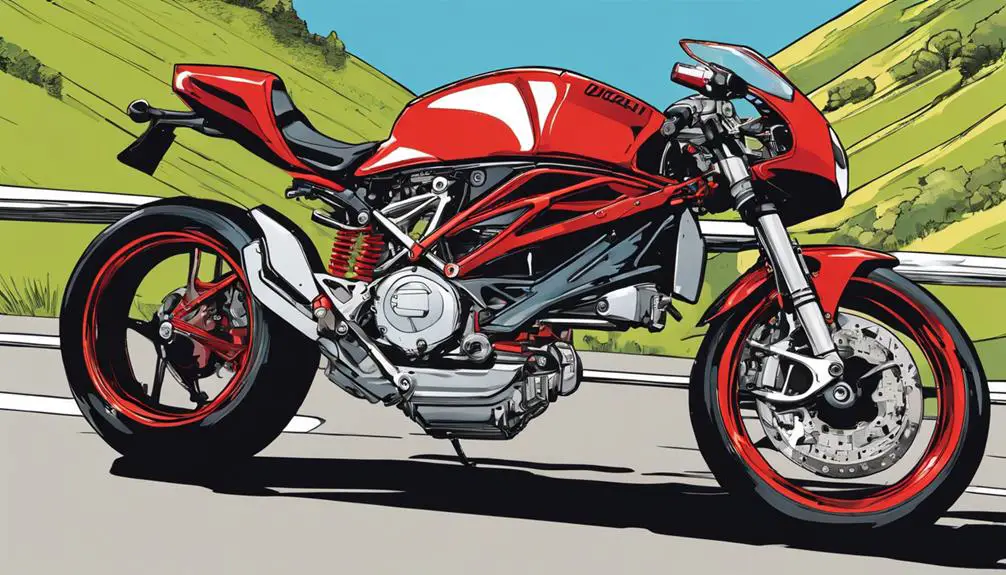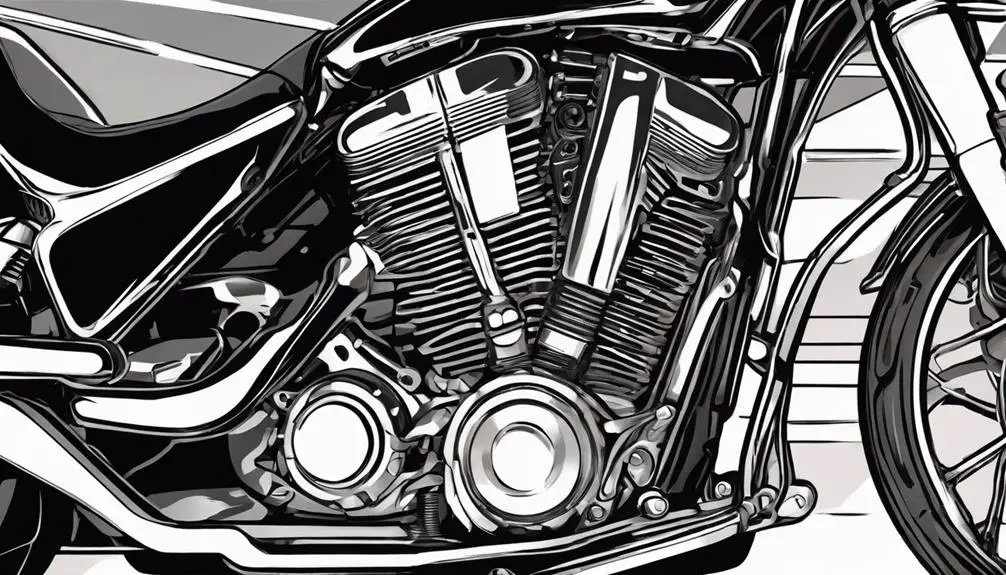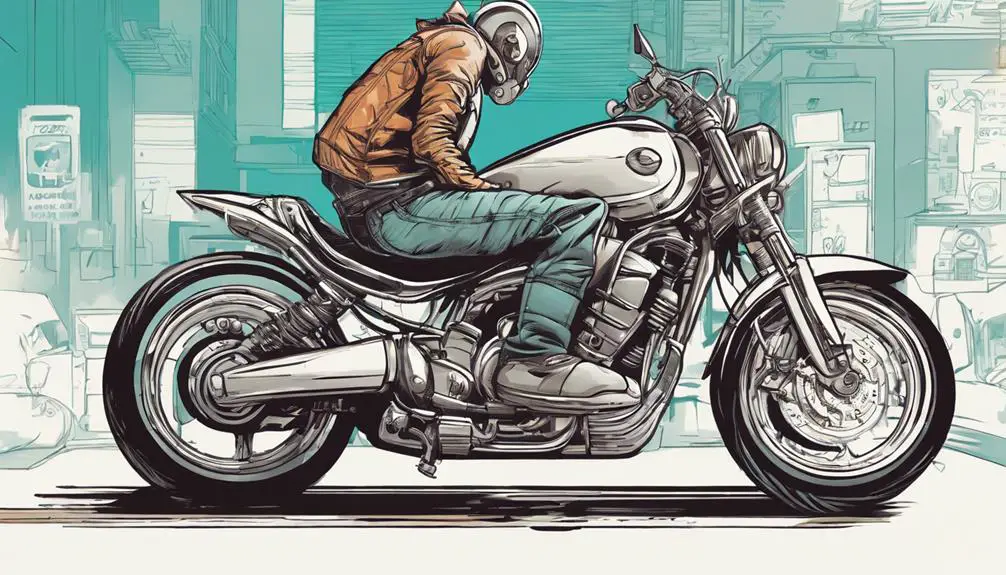Imagine a finely tuned machine gliding effortlessly through the wind; that's the essence of motorcycle design. You might not realize how deeply principles like aerodynamics and material choice influence your riding experience. Each element plays a vital role in crafting a bike that's not just fast, but also a joy to maneuver. As you consider what makes a motorcycle truly exceptional, you'll uncover insights that could reshape your understanding of performance and comfort. What are these key insights, and how do they transform your ride?
Key Takeaways
- Motorcycle design blends performance and style, reflecting continuous evolution and Italian craftsmanship.
- Aerodynamics is essential for stability and efficiency, with streamlined shapes reducing drag and enhancing comfort.
- Engine displacement and layout significantly influence power, handling, and overall riding experience.
- Lightweight materials improve agility, while thoughtful weight distribution enhances maneuverability and stability.
Ducati's Design Evolution

Since its inception, Ducati has continuously evolved its design philosophy to blend performance and style seamlessly. When you hop on a Ducati, you're not just riding a motorcycle; you're embracing a lifestyle that celebrates freedom and exhilaration. Each model reflects a commitment to innovation, showcasing sleek lines and bold aesthetics that ignite your passion for the open road.
Ducati's design evolution emphasizes the rider experience, ensuring that every detail serves a purpose. You'll notice how the ergonomics cater to comfort while maintaining a sporty stance, inviting you to push boundaries. The integration of cutting-edge materials not only enhances performance but also reduces weight, allowing you to feel the rush of acceleration like never before.
Moreover, Ducati's iconic Italian flair sets it apart, capturing the essence of rebellion and adventure. As you ride, you'll appreciate the meticulous craftsmanship and attention to detail that goes into every machine. The brand's journey reflects a relentless pursuit of perfection, where each new model builds on the last, pushing the limits of what's possible.
With Ducati, you're not just part of a community; you're part of a revolution in motorcycle design.
The Role of Aerodynamics
Aerodynamics plays an essential role in motorcycle design, greatly influencing stability and performance at high speeds. When you're cruising down the open road, the last thing you want to feel is the wind pushing against you, slowing you down and stealing your freedom. By focusing on aerodynamic principles, designers create streamlined shapes that reduce drag, allowing you to slice through the air effortlessly.
You'll notice that modern motorcycles often feature fairings and windshields, designed not just for aesthetics but to enhance your ride. These elements help direct airflow around you, improving stability and comfort, especially at high speeds. It's all about maintaining control, so you can fully embrace that exhilarating sense of liberation.
Moreover, a well-designed motorcycle can even improve fuel efficiency, giving you more miles to explore before needing to refuel. So, when you choose your bike, consider its aerodynamic features. They're not just technical specs; they directly impact your experience on the road.
You deserve a ride that maximizes your freedom, letting you conquer every curve and straightaway with confidence and style. Embrace the wind, knowing your bike's design supports you every mile of the way.
Engine Performance and Layout

While aerodynamics enhances your ride, engine performance and layout are equally essential in determining how much power and responsiveness your motorcycle delivers on the road. The heart of your bike, the engine, dictates not just speed but also how you feel when you twist the throttle.
Reflect on engine displacement; it's a key player in your motorcycle's performance. Larger engines generally offer more power, giving you that exhilarating rush. But it's not all about size.
The layout—whether it's a V-twin, inline-four, or single-cylinder—affects how your bike handles and responds. A V-twin might give you a throaty roar and torque that pulls you forward, while an inline-four could offer higher revs and a smoother ride.
You'll also want to reflect on the type of fuel system. Fuel injection systems provide better efficiency and throttle response, making your ride feel more alive.
Ultimately, the right combination of engine performance and layout transforms your motorcycle from a mere machine into an extension of your spirit, allowing you to embrace freedom on the open road. Choose wisely, and feel the liberation that comes with every ride.
Materials and Weight Distribution
The choice of materials in your motorcycle's construction greatly impacts its weight distribution and overall performance. When you opt for lightweight materials like aluminum or carbon fiber, you enhance agility and maneuverability, allowing for a more liberated riding experience.
These materials not only reduce the overall weight but also shift the center of gravity, giving you better control during sharp turns and acceleration.
On the other hand, heavier materials like steel can contribute to stability, but they may weigh you down, hindering your freedom on the open road. Understanding the balance between strength and weight is essential. For example, using a lightweight frame combined with a heavier engine can help you achieve the perfect equilibrium.
Moreover, consider how different components are positioned on your bike. By distributing weight thoughtfully—placing heavier parts lower and towards the center—you'll improve handling and responsiveness.
This conscious design allows you to feel the road beneath you, increasing your sense of freedom. Ultimately, the right choice of materials and weight distribution can transform your ride, making it a true extension of your spirit and passion for adventure.
Embrace the journey!
User-Centric Ergonomics

User-centric ergonomics focuses on creating a motorcycle that fits you perfectly, enhancing comfort and control during every ride. When you ride, you want to feel connected to your machine, not restricted by it. The right design accommodates your body, allowing you to maintain a natural posture that reduces fatigue over long distances.
To achieve this, manufacturers consider your height, weight, and riding style. They design adjustable seats, handlebars, and footpegs, ensuring you can customize your setup. You don't just ride; you engage with the motorcycle, experiencing the freedom and thrill of the open road.
The placement of controls plays a vital role too. You want them to be intuitive and within easy reach, so you can focus on the ride rather than fumbling for switches. This ergonomic approach increases your confidence and enhances your ability to react swiftly in various conditions.
Ultimately, user-centric ergonomics isn't just about comfort; it's about liberation. It empowers you to push boundaries, explore new horizons, and enjoy every twist and turn without the burden of discomfort. Choose wisely, and your motorcycle will become an extension of your spirit.
Frequently Asked Questions
How Do Different Motorcycle Styles Affect Design Choices?
Different motorcycle styles shape your design choices considerably.
If you're drawn to cruisers, you'll prioritize comfort and a low seat height for relaxed rides.
Sportbikes, on the other hand, demand a focus on aerodynamics and agility, pushing you to reflect on lightweight materials.
Adventure bikes call for rugged durability and versatility.
Each style reflects your spirit of freedom, so embrace the design that resonates with your quest for liberation and the open road.
What Safety Features Are Commonly Integrated Into Motorcycle Designs?
When you think about safety features in motorcycle designs, it's essential to understand that modern bikes often integrate advanced technologies.
You'll find anti-lock braking systems (ABS), traction control, and cornering stability control as standard in many models.
Some even include advanced lighting systems and adjustable suspension to enhance ride stability.
These features not only protect you but also empower your ride, letting you embrace the freedom of the open road with confidence.
How Does Environmental Impact Influence Motorcycle Design Today?
Today, environmental impact plays a huge role in motorcycle design.
You'll find manufacturers focusing on lightweight materials and more efficient engines to reduce emissions.
Innovations like electric models are gaining traction, showing a commitment to sustainability.
By choosing eco-friendly options, you not only help the planet but also enjoy the benefits of advanced technology.
Embracing these changes means you're part of a movement toward cleaner, greener riding experiences that align with your desire for freedom.
What Are the Most Popular Colors and Finishes in Motorcycle Design?
Did you know that over 30% of riders prefer black motorcycles? It's no surprise—black exudes a sleek, rebellious vibe that screams freedom.
Along with black, bold colors like red and metallic finishes are also rising in popularity, representing power and passion.
You'll often see eye-catching chrome accents, too, adding that touch of elegance.
Choosing the right color and finish can make your bike feel like an extension of your personality and your adventurous spirit.
How Do Custom Modifications Alter the Original Design Principles?
Custom modifications can dramatically alter a motorcycle's original design principles, allowing you to express your individuality and freedom.
When you change components like the exhaust, handlebars, or paint, you're not just enhancing aesthetics; you're also affecting performance and comfort.
Each tweak can redefine how you connect with the bike, making it truly yours.
Embrace those modifications, and let your motorcycle reflect your unique journey and style on the open road.
Conclusion
In summary, understanding motorcycle design principles can truly enhance your riding experience.
Did you know that a well-designed aerodynamic motorcycle can improve fuel efficiency by up to 30%?
By focusing on aerodynamics, engine layout, lightweight materials, weight distribution, and ergonomics, you can reveal the full potential of your ride.
So, whether you're cruising or cornering, remember that these design insights not only boost performance but also make every ride more enjoyable and thrilling.